Summary of Climate Disasters on the planet from June 26 to July 2, 2024
Europe
Germany
Since June 26, extreme weather conditions have been observed in many federal states of Germany.
In Detmold, North Rhine-Westphalia,
up to 100 liters of rain per square meter fell within a short time.
2 km of federal highway 239 were flooded, while water levels on the ring road reached 60 cm. Firefighters responded 150 times, pumping water from flooded basements.

Streets flooded by heavy rain, Germany
In Baden-Württemberg, rail traffic was disrupted for several days. City railway services in Stuttgart also had interruptions. In the city of Sinsheim, rain completely flooded the interior of the PreZero Arena stadium.
In Thuringia, the village of Gerthausen, in the municipality of Röblingen, was severely affected. The Herpf River overflowed in minutes, submerging the streets under half a meter of water. In Hamburg, streets, basements, shops, and underground parking lots were flooded.
The storms also negatively impacted the European Football Championship, which is currently taking place in Germany.
During the Germany Vs. Denmark match in Dortmund, a severe thunderstorm with hail erupted. Due to dangerous weather conditions, the game was suspended for almost 30 minutes.

Thunderstorm during the match in Dortmund, Germany
In Stuttgart, due to the storm, fans were temporarily evacuated from the fan zone on Schlossplatz, which accommodates 30,000 people. As a result, the public viewing of the championship started much later than scheduled.
In Frankfurt, despite the participation of the German national team in the match, city authorities decided not to open the fan zone at all, as it would be unsafe to be there due to weather conditions.
Poland
On June 28, a severe storm swept across Poland. The greatest damage was recorded in the Subcarpathian and Greater Poland voivodeships.

Trees felled by strong wind, Poland
In the city of Gdansk, wind speeds reached force 12 on the Beaufort scale, exceeding 120 km/h (75 mph). Due to the powerful gust, a huge shipyard crane collapsed into the port channel.
In Warsaw, strong winds blew down everything in their path. People on the streets had to run for safety from the storm. The downpour instantly turned the streets into raging torrents. In the commune of Ustrzyki Dolne, Subcarpathian voivodeship, a car was swept away by the rushing water, unfortunately, the driver did not survive.
Russia
On July 1, the daytime temperature in St. Petersburg rose to
a record 33.2 °C (91.8 °F),
and in the evening, a thunderstorm with a dust storm and heavy rain hit the city and the Leningrad region.

Dust storm in St. Petersburg, Russia
The wind tore off roofs, trees fell, blocking roads and crushing cars, everything not secured was flying around. Dozens of cars were damaged, hundreds of trees were uprooted, a tower crane and scaffolding collapsed due to the storm.
At Pulkovo Airport,
wind speeds reached 31 m/s (69 mph),
causing several planes to divert to alternate airports.
During the thunderstorm, lightning struck transformers, disrupting electric train traffic. Tens of thousands of customers were left without power.

Trees uprooted during the storm, St. Petersburg, Russia
Unfortunately, three people died, and at least ten were hospitalized.
On the same day, strong winds raged in the Novgorod region. Due to trees falling on power lines, many settlements were left without electricity. In Veliky Novgorod, the wind during the thunderstorm knocked down a famous city landmark— the oak tree which was over 400 years old. It’s hard to imagine the strength of the wind gust that uprooted the giant tree with a trunk diameter of 1.16 m and a height of 13 m.
Asia
Russia
Since June 22, a record-breaking heatwave in the past 50 years persisted in Siberia for over a week. Dozens of records were broken, and temperatures rose above 37 °C (98.6 °F). In the city of Minusinsk, 37.7 °C (99.9 °F) was recorded on June 30.
On June 29, in Krasnoyarsk, the temperature reached a record 35.2 °C (95.4 °F) for that month. The previous record stood for nearly 100 years (since 1928). In the city, roads were sprayed with water to cool the asphalt and prevent it from deforming under car tires.
According to the Ministry of Health of the Krasnoyarsk Territory, in less than a month in June,
at least 22 cases of heat stroke or fainting were recorded in the region.
Kyrgyzstan
At the end of June, heavy torrential rains caused destructive mudslides in several regions of Kyrgyzstan. On June 28, in the Nookat district of the Osh region, mudflows flooded dozens of yards, damaged bridges, roads, and electrical substations. A state of emergency was declared in the district.
People in the Abshir-Ata recreational area were severely affected.
The mudflow washed away the road to the namesake waterfall, trapping about 1,300 people in the valley. Helicopters were deployed to evacuate people.
Rescuers ferried 180 people across the river. Unfortunately, mudflows swept away people who were resting on the riverbank. According to the Ministry of Emergency Situations of Kyrgyzstan, as of June 30, 10 people died. All the victims were members of one family.
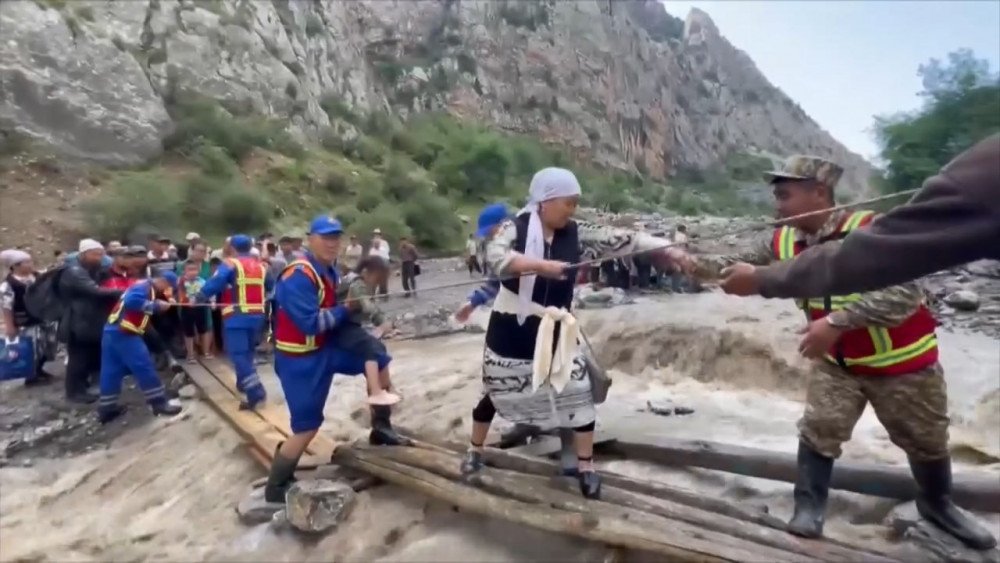
Rescuers helping people cross the river in the Abshir-Ata recreational area, Kyrgyzstan
To mitigate the aftermath in Abshir-Ata, 637 people and 19 units of special equipment were involved.
Another tragedy occurred on June 30 in the village of Kara-Kulja in the Osh region: a mudslide swept away a car carrying a family of five. Only one child survived.
China
Heavy rains continue to wreak havoc in China. This time, the east and southeast regions of the country were hit hardest. The provinces of Hunan, Anhui, and Jiangxi suffered the most. In just two provinces, around 2 million people were affected: over 800,000 people in Anhui province and over 1 million people in Jiangxi province. Residents are in urgent need of assistance.
According to the Ministry of Water Resources of China, due to the rains that started on June 25, the water levels in 90 rivers in the Yangtze River basin exceeded critical levels.
Although the flood season is just beginning, 21 provinces have already been affected by floods.
Pingjiang District, Yueyang City, Hunan Province, experienced
the most severe flooding in its recorded history.
The torrential rains affected 340,000 people.
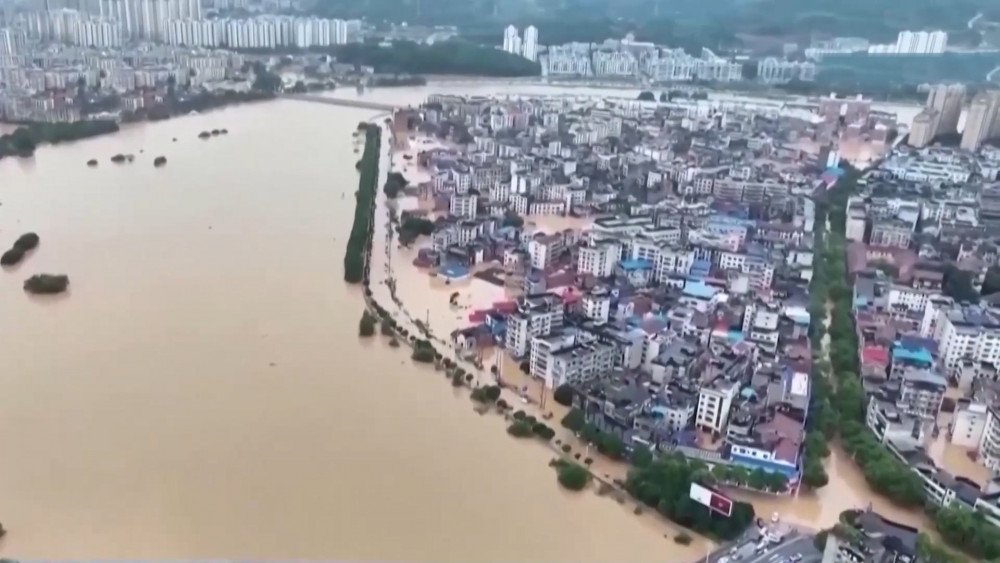
Historic flood in Pingjiang District, Hunan Province, China
On July 2, the water level in the Miluo River at Pingjiang Station was recorded at 77.67 meters, which is the highest level in the past 70 years (since 1954). It exceeded the flood warning level of 70.50 meters by more than 7 meters.
Over 2,600 bridges and roads
were washed away and destroyed by landslides,
and some areas were left without electricity and communication.

Road collapse in Pingjiang District, Hunan Province, China
Compared to previous years, the floods in China in 2024 started earlier and were more intense. Water levels in 471 rivers exceeded critical levels, which is twice the usual figure for the same period in 2023.
North and South America
Hurricane Beryl
Beryl formed in the Atlantic Ocean at the end of June. In just 42 hours, it transformed from a tropical depression into a powerful hurricane and became the earliest Category 4 hurricane observed in the Atlantic.
On July 1, it struck the Caribbean countries, heavily impacting Grenada.
In just half an hour, Beryl destroyed the infrastructure of the islands of Carriacou and Petite Martinique,
damaging or destroying 98% of buildings.
The islands were left without communication and electricity. Carriacou was almost completely stripped of vegetation, including the total destruction of mangrove forests.
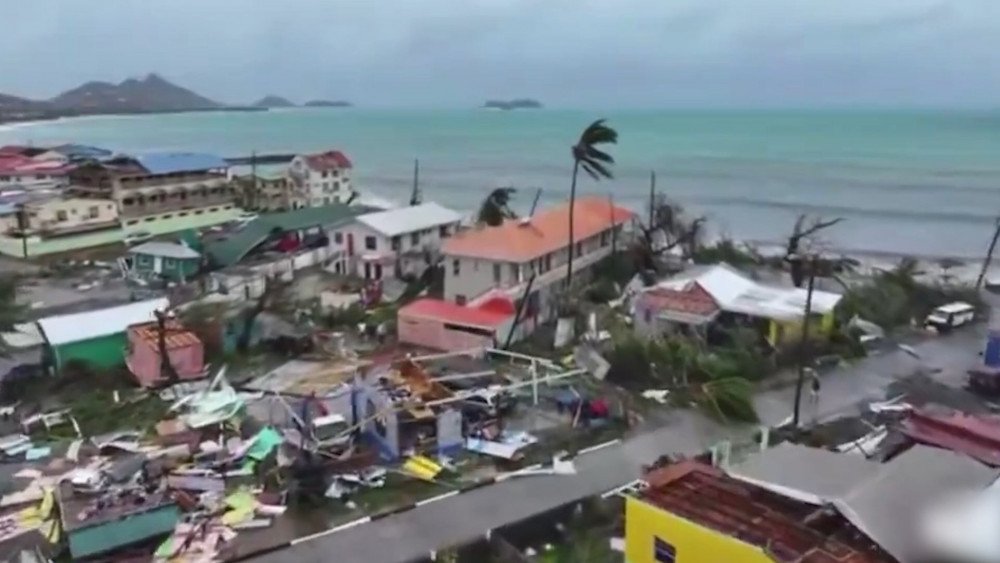
Severe destruction after the hurricane Beryl in Grenada
On the island of Saint Lucia, streets were littered with banana trees, downed power lines, and various debris. Many animals died.
In Saint Vincent and the Grenadines, hurricane Beryl devastated Union Island, damaging and destroying 90% of homes, as well as the local airport.
In Barbados, significant damage was done to the boats at the Bridgetown Fisheries complex, with many of them sinking.

Sunken boats at the Bridgetown Fisheries complex, Barbados
Thousands of people who came for the Twenty20 Cricket World Cup final were stranded on the island as their flights were canceled.
In the Dominican Republic, huge waves reached power lines along the coast, causing short circuits.
In Venezuela, torrential rains brought by the hurricane caused the Manzanares River to overflow. As a result of the chaos, three people died, and five are missing.
25,000 people were affected.
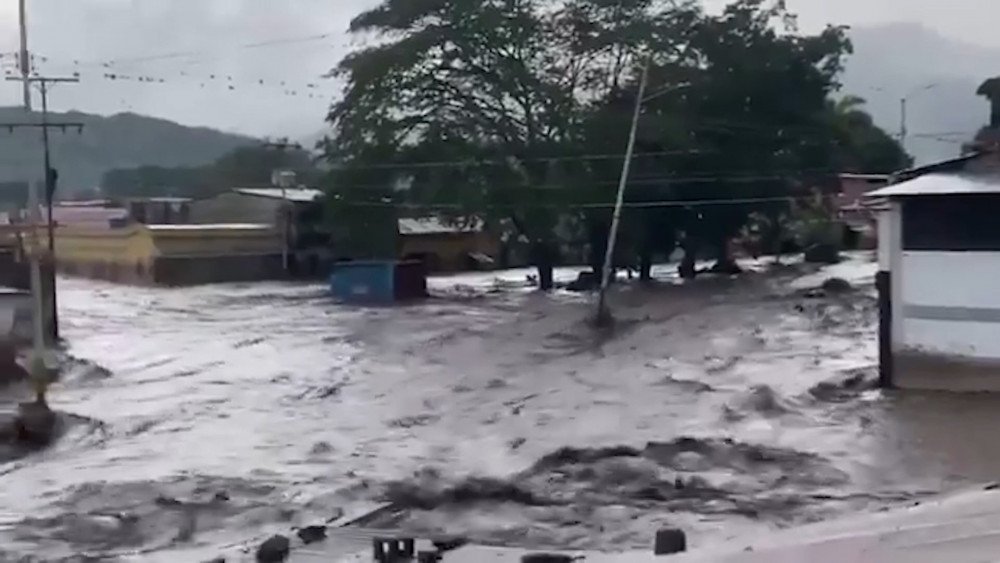
Manzanares River overflow, Venezuela
Argentina
An unprecedented wave of cold and abnormal snowfalls hit Argentina this winter season. Such snowfall has not been seen here in about 30 years.
Snowfalls were recorded even in Buenos Aires province, in the cities of Sierra de los Padres, Batan, and Mar del Plata, which is absolutely abnormal for this region, as the average temperature in June in Buenos Aires is +11 °C (52 °F).
In the Argentinian region of Patagonia, heavy snowfalls blocked roads. Soldiers of the Argentinian army were deployed for rescue operations.
Enormous damage was inflicted on the livestock sector. Due to the deep snow cover, animals could not only find food or even move.

Deep snow cover in Patagonia, Argentina
Enrique Jamieson, president of the Federation of Agricultural Institutions of Santa Cruz and the Agricultural Society of Rio Gallegos, commented on the situation in the province: “The situation in Santa Cruz is very complex, the snowfall extends from north to south and from the central strip towards the west affecting 50% of the cattle and sheep 'stock', about 40,000 cattle and 1 million sheep.”
The abnormal cold wave froze not only the air but also the sea.
In the Tierra del Fuego province, the temperature dropped to -15 °C (5 °F), causing
an extremely rare phenomenon: sea waves turned into ice.
Images that went viral on social media showed the partially frozen sea off the coast of San Sebastian Bay.

Frozen sea off the coast of San Sebastian Bay, Tierra del Fuego province, Argentina
Mexico
Residents of the municipality of Tula, in Mexico’s state of Tamaulipas, heard a rumble and creaking sound, after which giant cracks appeared in the ground. According to eyewitnesses, their width reaches 3 meters (9.8 feet), and in some sections, the depth is up to 15 meters (167 feet). The total length already extends about 6 km (3.7 miles) and continues to grow. There were also reports of sinkholes appearing in the region.
Santiago Martinez described the phenomenon that greatly surprised him and other locals: “Here the crack stretches about a kilometer and a half from ranch to ranch because it has already reached San Miguel del Carmen and crosses local roads. What seems strangest to us is that the day before yesterday it was dry, and yesterday it was filled with a lot of water, almost up to the top, even though it didn't rain for there to be any water.”
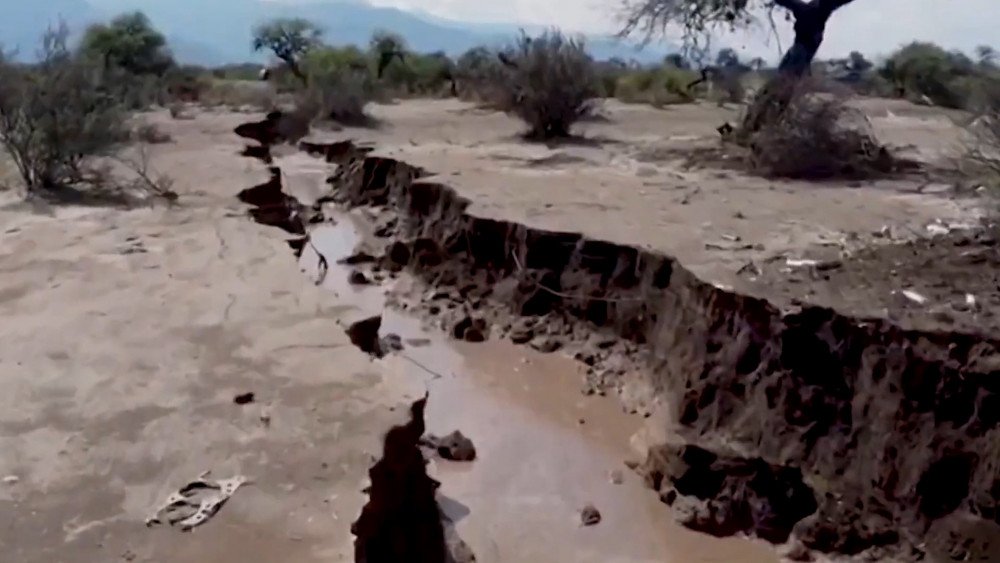
Giant earth crack in Tamaulipas, Mexico
The fissures have passed through farmers' plots, seriously affecting agriculture.
The cracks came very close to residential areas, crossed many rural roads, and approached the federal highway Mante – Ocampo – Tula. Residents of the municipality of Tula are fearful because they may not only be cut off from the outside world but also lose their homes.
USA
On June 27, abnormally warm and unstable weather in the Arctic regions of Alaska caused rare and powerful thunderstorms. Wind gusts reached 50 mph (80 km/h), and quarter-sized hail.
Typically, summer thunderstorms in the interior of Alaska bring only a few hours of lightning per month.
But this time,
over 24 hours, sensors recorded 78,506 lightning events
across about 260 square miles (673 sq. km).
This accounts for approximately
half a month’s entire lightning total.

Anomalous number of lightning strikes recorded in the Arctic regions of Alaska, USA
Noteworthy is not only the number of lightning strikes but also their location. According to the Alaska climatologist Brian Brettschneider, Severe Thunderstorm Warnings in northwest Alaska were the northernmost that the NWS has ever issued, beyond the Arctic Circle, which starts at 66.5622° N.
On June 27, a warning issued for the region reached 68.37 degrees North and 164.64 degrees West.
The lightning caused dozens of wildfires in Alaska this summer. The Bureau of Land Management for Alaska reports that as of June 27, there are 144 active wildfires burning in the state, including 38 new fires that have started since midday June 26.
Turbulence
An Air Europa flight from Madrid to Montevideo was forced to make an emergency landing in Natal, Brazil.
The plane entered a turbulence zone, and after light shaking, it suddenly began to lose altitude. The fall lasted only a few seconds, but during that time, passengers experienced true horror.
Those whose seat belts were not fastened hit the ceiling of the cabin, and one person was trapped in the luggage compartment.
About 30 people sustained various injuries and were hospitalized. Four of them were in intensive care.

Man got stuck in an overhead compartment due to severe turbulence
It is impossible not to notice the sharp increase in cases of severe turbulence, leading to injuries and even fatalities.
Airlines can no longer ignore this problem and hope to solve it by changing flight rules. For instance, after an almost twofold increase in turbulence incidents in 2024, Korean Air announced that since on the 1st of July they will end in-flight services 40 minutes prior to landing. Passengers are advised to always keep their seat belts fastened and securely store their luggage.
Global turbulence statistics for Korean domestic airlines:
Q1 2023: 3,473 incidents;
Q1 2024: 6,246 incidents.
Such measures are merely an adaptation and do not address the root causes of this dangerous phenomenon. Scientists estimate that the number of turbulent pockets in the atmosphere will increase rapidly, especially in the upper layers, at altitudes of 8 km (5 miles) and above, where most airliners fly. The time will come when there will be so many air pockets that flying will become impossible. Moreover, in the coming years, climate catastrophes will intensify worldwide, and the planet could face total destruction within 10–12 years.
Currently, humanity still has the opportunity to prevent the negative scenario. But for this, it is necessary for the true causes of climate change to become the most discussed agenda. Therefore, the hope lies with those people who have already realized the criticality of the situation and can explain it to others.
It is necessary to unite the scientific potential of the entire global community right now to address this critical issue. You can find more information at the forum “Global Crisis. The Responsibility”.
You can watch the video version of this article here.
Leave a comment